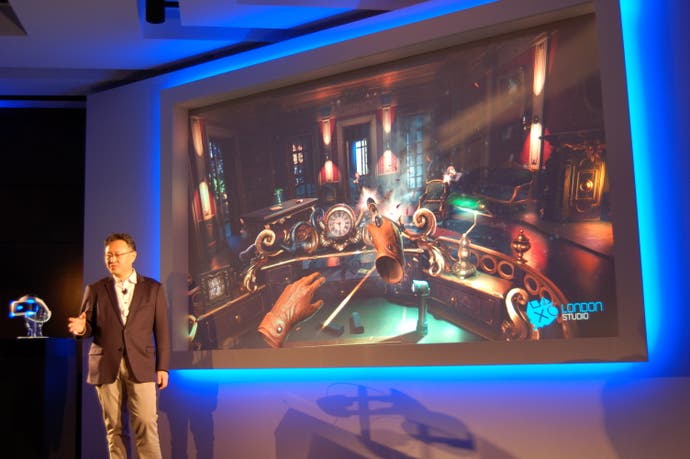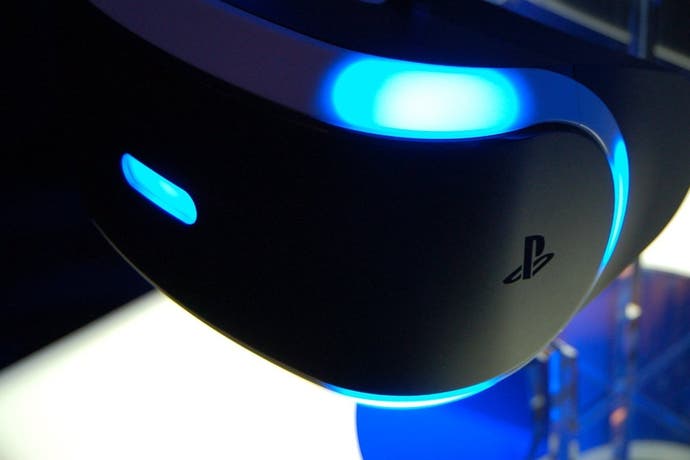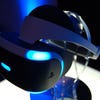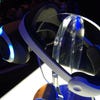Digital Foundry: Hands-on with Sony's near-final Project Morpheus
Impressions from Sony's GDC 2015 presentation, and London Studio's new Heist demo.
You're probably fully aware of the revised spec for the Project Morpheus development kit by now, said to closely resemble the capabilities of the final model: a native 1080p display is in place with full RGB sub-pixel precision, OLED display technology is a lock, with a phenomenal 120Hz refresh confirmed. The spec is highly impressive on paper, but how does it feel once the visor is lowered into place?
We can safely say that it's a significant improvement over the already impressive developer HMD we've already tested. Looking beyond the raw spec, at the more practical level, Sony's designers have created a significant milestone in crafting a lightweight headset, the redesigned strap not placing any significant pressure on your face, distributing and balancing weight between the forehead and the back of your skull. It feels comfortable to wear, and we're curious to see how it holds up for extended periods.
The visor slots into place nicely - there's a button on the right of the underside that you hold down in order to move the display towards or away from your face. On a practical level, it works in setting yourself up for the best possible immersion offered by the kit, and it doubles up as means by which you can temporarily move the display away to orientate yourself in the environment. We're also happy to report that Sony has solved the troublesome 'glasses issue' - as a wearer of spectacles myself, there were no problems whatsoever with the HMD clashing with my eyewear. Also worthy of note is that no form of calibration is required - once the visor is comfortably in place, everything just works.
While it's been a while since we tested the older LCD model, we spotted two clear improvements over the initial prototype. Firstly, the enhanced field of view creates a more potent form of immersion - the black 'borders' that framed the left and right of the image previously are still there, but significantly reduced and now in peripheral vision. Secondly, and perhaps more crucially, image quality is also improved. It's not a revelatory change - the previous model also featured a full 1080p RGB display - but the motion blur is significantly reduced thanks to the lower persistence of the new, larger 5.7-inch OLED display.
We only played the one demo - London Studio's Heist - and it allowed us to sample what is going to be a crucial element of the Morpheus SDK. The demo itself is visually rich, apparently running at 60fps, but the PS4 uses a form of frame-rate upscaling that Sony calls reprojection in order to give the illusion of a higher frame-rate. The idea is that midway between rendering each native image, the PS4 interpolates an intermediate frame based on revised motion data fed to the console from the HMD. Right now we'd say that the jury's out on the technology - it didn't exactly feel as though it was running at a significantly higher frame-rate and indeed, at some points it felt that the 60fps target wasn't adhered to. However, even if we're not quite dealing with super-slick perfection, the quality of the immersion is absolutely remarkable. This is VR that not only works but leaves a lasting impression. An hour on from the hands-on session and I'm still excited about it.
The demo begins with your avatar tied to a chair, facing interrogation from a hardman character in the Vinnie Jones mode. Stationary in the chair, there's not much you can do other than let the story play out, and allow your captor to blow smoke in your face - an interesting experience in stereoscopic 3D. However, as the interrogation continues, your gaze naturally wanders - you can look around the room in full 360 degrees across all axes. That's when the feeling of immersion really hits home. It's about acclimatising to your place in the virtual world.
It's not long before you're out of your seat, and exploring the environment, starting off with a quick tutorial on interaction with the game world via dual PlayStation Move controllers - one for each hand. Just like the castle demo we previously tested, Move is tracked in the real world, projecting your hands into the virtual environment. The Move triggers allow you to grasp anything you like - principally drawers you can open, and objects you can grab, hold in your hands, drop or throw.

Your bodily position is tracked too, and this is crucial for locating the all-important pistol - it's hidden in a bottom drawer, requiring you to lean down and open it. As a full-on firefight breaks around you, attempting to return fire proves fruitless: the gun is not loaded. Not to worry though, you simply grab a spare magazine with your spare hand and physically load it before returning fire. Ammo is limited per clip requiring you to grab surplus mags and reload. Gunplay feels good, and accurate but the height of the experience is short-lived. The demo ends prematurely with a 'to be continued' message, leaving you hungry for more.
The demo is short and sweet but does enough to demonstrate that PlayStation 4 has the power to create a visually detailed experience while maintaining a coherent stereoscopic image at a sufficiently high frame-rate. It feels as if it has the quality to work as a full game, though beyond the confines of the demo you do have to wonder whether it would work as anything other than an on-rails experience.
It also serves to remind us that while Sony has - quite rightly - aimed for high frame-rates and fast response, we are still dealing with a 1080p image, which remains just as soft as it did on the prototype. The right trades have been made though. The lack of clarity doesn't detract from the quality of the overall experience, and obvious image quality artefacts - like edge-aliasing for example - are relatively slight. We spotted some minor jaggies on the shoulders of our captor, but that was it.
Secondly, the Heist demo emphasises the importance of PlayStation Move as an intuitive way to interact with the game world. While we didn't have access to the other three demos Sony has brought to GDC (we'll be looking at those later in the week), our prior experience of Morpheus demos using a standard Dual Shock 4 pad just isn't in the same league. What's really impressive about the London Heist demo is that interaction with the game world is intuitive - and obvious. There are no visual cues about where to find the gun, or how to load it - doing so is simply second nature. In the process, it feels fresh and exciting.
As a taste of what is to come when Morpheus arrives as a retail product in the first half of 2016, the London Heist demo is mouthwatering. What we have here is a carefully crafted experience with full console-level production values, working in combination with highly impressive hardware. Sony has brought three more demos to GDC that we'll be sampling later in the week - including a full 120fps experience - and we can't wait to try them out.














